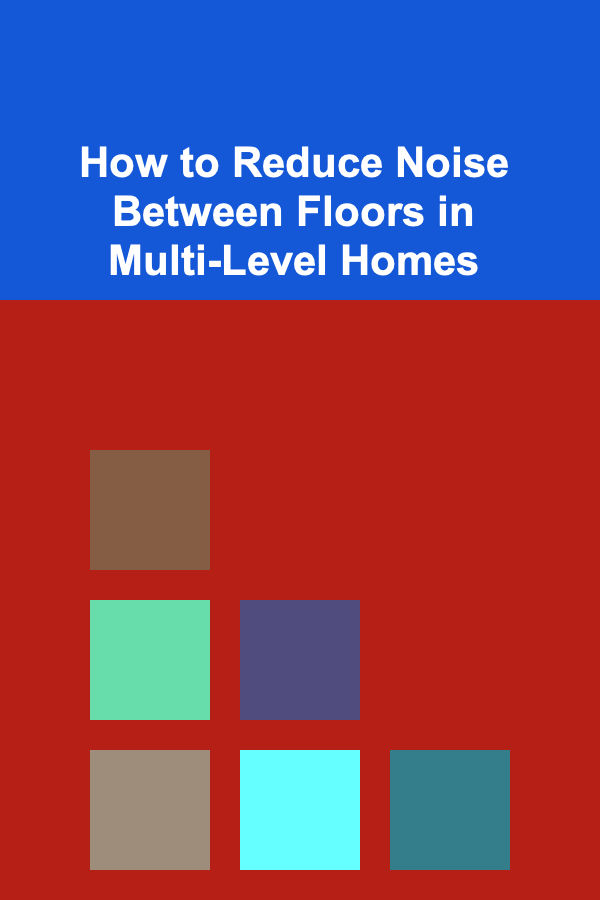
How to Soundproof a Home Office for Video Calls
ebook include PDF & Audio bundle (Micro Guide)
$12.99$8.99
Limited Time Offer! Order within the next:

With the rise of remote work, having a functional and quiet home office is more important than ever, especially for those who frequently participate in video calls. Whether it's an important business meeting, a conference call, or a casual check-in with a colleague, the sound quality in your environment plays a crucial role in how others perceive you. In an ideal setup, the background noise should be minimal, the acoustics should be optimal, and distractions should be nonexistent. Achieving this requires more than just finding a quiet space in your home; it requires a strategic approach to soundproofing.
This comprehensive guide will delve into various methods for soundproofing your home office, particularly focusing on techniques that can improve the sound quality of video calls. From basic DIY fixes to more advanced, professional-grade solutions, this article will help you create a quieter, more professional environment where you can work without interruptions or distractions.
Why Soundproofing Matters for Video Calls
Before we dive into the steps of soundproofing your home office, it's essential to understand why it's necessary in the first place.
1. Minimizing Distractions
Noise distractions, whether they come from the outside world or from within your home, can be incredibly disruptive during video calls. Background noise, such as traffic, pets, children, or household appliances, can distract both you and your meeting participants. Furthermore, noises that come from the other side of your microphone or speakers can be annoying to listeners and reduce the overall professionalism of the call.
2. Improving Communication Clarity
For effective communication, clear sound is critical. If the acoustics in your home office are poor, your voice may sound muffled or distant, making it hard for others to understand you. This is especially true in rooms with excessive echo or reverberation. Proper soundproofing ensures that your voice is transmitted clearly without distortion.
3. Creating a Professional Environment
Professionalism is not just about how you look on camera, but also about how you sound. Unclear audio, background noise, or echoing can give the impression that you're not well-prepared or that your work environment is not conducive to professional communication. Soundproofing can help you maintain a polished and professional image.
4. Maintaining Privacy
When working from home, privacy can be a concern. Noise leakage from your home office could expose sensitive information to other people in your household, and vice versa. Soundproofing helps ensure that conversations and meetings remain confidential.
Steps to Soundproof Your Home Office
Now that we've covered the importance of soundproofing for video calls, let's dive into practical methods you can use to minimize sound interference and create an ideal workspace.
1. Choose the Right Location
The first step in soundproofing is selecting the right location for your home office. While it may not always be possible to control the layout of your home, choosing a quiet area will give you a head start.
Considerations for Location:
- Away from busy areas: Set up your office in a space that is far from noisy parts of your home, such as the kitchen, living room, or rooms where others are likely to have meetings or conversations.
- Use rooms with natural barriers: If possible, choose a room with fewer windows or walls that face outward, as external noise from the street or neighborhood can seep through.
- Look for rooms with carpets and curtains: Soft surfaces naturally help absorb sound. Rooms that have carpets, rugs, or heavy curtains are better suited for soundproofing than those with hard floors and bare walls.
2. Seal Gaps and Cracks in Windows and Doors
One of the most common ways sound leaks into a room is through gaps and cracks around windows and doors. Sealing these gaps can prevent unwanted noise from entering your workspace.
How to Seal Gaps:
- Weatherstripping: Use weatherstripping around doors and windows to seal off small gaps. This material is easy to install and is available in various forms, such as adhesive strips or foam seals.
- Door sweeps: Install a door sweep on the bottom of your office door to block sound from entering under the door. This is especially important if you have a door that opens into a high-traffic area of your home.
- Window seals: If your windows are particularly drafty, consider using thick window seals or weatherproofing tape to cover any small gaps around the edges.
3. Soundproofing Windows
Windows are one of the weakest links when it comes to noise isolation. The thin glass used in most windows can easily transmit external sounds into your home office. Fortunately, there are several ways to reduce the sound coming through your windows.
Methods to Soundproof Windows:
- Double-glazing or secondary glazing: Replacing single-glazed windows with double-glazed windows is one of the most effective ways to reduce sound transmission. If you're not ready for a full window replacement, adding a second layer of glass (secondary glazing) can significantly improve soundproofing.
- Acoustic window film: Another option is to apply an acoustic window film to the glass. This thin, transparent film can help absorb sound and reduce noise coming through the window.
- Heavy curtains or acoustic drapes: Install heavy curtains or acoustic drapes over your windows. These fabrics help absorb sound and prevent it from entering the room. They are particularly useful if replacing windows isn't an option.
4. Soundproofing Walls
Walls are another key area to focus on when soundproofing your home office. In many cases, the soundproofing of walls involves adding additional layers or treatments to block and absorb noise.
Techniques to Soundproof Walls:
- Add mass-loaded vinyl (MLV): MLV is a dense, flexible material that can be attached to walls to block sound transmission. This material is especially effective at reducing low-frequency noise.
- Install acoustic panels: Acoustic panels are designed to absorb sound and reduce echo. These panels can be mounted on walls to improve the overall acoustics of your office. Look for panels made from materials like foam or fiberglass, which are excellent at sound absorption.
- Use soundproof drywall: If you're willing to invest in more permanent solutions, consider using soundproof drywall. These special types of drywall have sound-dampening layers that can block noise more effectively than regular drywall.
- Decouple the walls: In more extreme cases, you may want to consider decoupling the walls. This method involves creating a separation between the wall and the studs using materials such as resilient channels or sound isolation clips. While this is an advanced technique, it can significantly reduce noise transmission.
5. Treat the Ceiling and Floor
In addition to the walls, consider soundproofing your ceiling and floor to further reduce noise interference.
Soundproofing the Ceiling:
- Acoustic ceiling tiles: These tiles are designed to absorb sound and reduce noise that travels between floors. If you have a noisy neighbor or if your home office is in an upstairs room, installing acoustic ceiling tiles can help dampen sound from above.
- Insulation: Adding insulation to the ceiling can also help absorb sound. Consider using fiberglass or cellulose insulation for maximum soundproofing.
Soundproofing the Floor:
- Carpets and rugs: Hard floors such as wood, tile, or laminate can reflect sound and create an echo in your office. Adding soft materials like carpets, rugs, or even foam floor tiles can reduce the amount of sound bouncing around the room.
- Soundproof underlay: For an added layer of soundproofing, install a soundproof underlay beneath your carpet or rug. These underlays are designed to absorb sound and prevent it from traveling to other parts of the house.
6. Use Acoustic Treatment for Better Sound Quality
In addition to blocking external noise, it's important to improve the internal acoustics of your home office. This can help prevent the sound of your voice from bouncing around the room and causing echo or distortion during video calls.
Tips for Acoustic Treatment:
- Place acoustic panels strategically: Position acoustic panels at key reflection points, such as on the walls directly facing your computer or camera. This helps reduce the amount of sound bouncing off the walls and improves the clarity of your voice.
- Use bass traps: If you have a large home office with lots of space, bass traps can help absorb low-frequency sounds and prevent an overly "boomy" or echoey effect in the room.
- Ceiling clouds: If your office has a high ceiling, consider installing a ceiling cloud (a suspended acoustic panel) to reduce the sound reflections from above.
7. Consider Additional Noise Control Tools
Finally, there are several additional tools and technologies you can use to further improve soundproofing and reduce distractions during video calls.
Noise-Canceling Headphones
Noise-canceling headphones are ideal for blocking out ambient noise, particularly in open or noisy environments. If you're in a shared space, these headphones can help you focus on the call without being disturbed by background noise.
White Noise Machines
If external noise remains a problem, a white noise machine can mask unwanted sounds and create a more consistent sound environment. These machines emit soothing background noise that helps block out distractions from your surroundings.
Conclusion
Soundproofing a home office for video calls is an investment in both your professional image and your overall productivity. By following the steps outlined in this guide, you can effectively reduce unwanted noise, improve the acoustics in your office, and create an environment that is conducive to clear communication during video calls. From choosing the right location to using advanced soundproofing materials, there are numerous strategies you can implement to optimize your workspace. Whether you're looking to block external noise, prevent echo, or maintain privacy, these soundproofing techniques will help you create a home office that allows you to work efficiently without interruptions.
Reading More From Our Other Websites
- [Ziplining Tip 101] The Zipline Challenge: Turning a Thrill Ride into a Blueprint for New Beginnings
- [Personal Care Tips 101] How to Choose a Long-Wearing Foundation for Special Events
- [Sewing Tip 101] Genius Sewing Hacks Every Beginner Should Know
- [Home Budget 101] How to Cut Back on Subscription Services and Stay on Budget
- [Home Rental Property 101] How to Rent a House with an In-Law Suite: A Guide for Multi-Generational Families
- [Home Budget Decorating 101] How to Add Texture and Warmth to Your Home on a Budget
- [Home Cleaning 101] How to Speed Clean Your Home in Less Than an Hour
- [Home Renovating 101] How to Replace Old Windows and Save on Energy Costs
- [Home Storage Solution 101] How to Store Your Wine Collection in Style and Safety
- [Home Budget Decorating 101] How to Decorate Your Bedroom on a Small Budget

Generating Passive Income with Deep Learning APIs
Read More
How to Build a Successful Long-Term Rental Business
Read More
How to Create a Study Space That Promotes Focus
Read More
How to Reduce Noise Between Floors in Multi-Level Homes
Read More
Mastering Electrical Engineering: Essential Skills for Innovation and Problem Solving
Read More
Using a Cooling System Pressure Tester to Find Leaks
Read MoreOther Products

Generating Passive Income with Deep Learning APIs
Read More
How to Build a Successful Long-Term Rental Business
Read More
How to Create a Study Space That Promotes Focus
Read More
How to Reduce Noise Between Floors in Multi-Level Homes
Read More
Mastering Electrical Engineering: Essential Skills for Innovation and Problem Solving
Read More